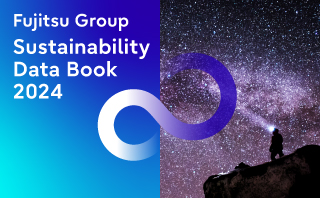- Sustainability at Fujitsu Group
- Global Responsible Business
- Governance
-
Data and Documents
- Fujitsu Group Sustainability Data Book 2024
- Social, Governance and Environmental data
- Independent Assurance Report

- GRI Standards / United Nations Global Compact (UNGC) principles Comparison Table
- SASB Standards Comparison Table
- Sustainability Information Disclosure Framework
- Link to regions responsible business reports
- Contact
- Sitemap
Material Balance
Environmental impact of business activities
INPUT
| Stage | Unit | FY2020 | FY2021 | FY2022 | FY2023 | |
|---|---|---|---|---|---|---|
| Design /
Procurement / Manufacturing / Development | Raw Materials | |||||
| Metal | ktons | 11(*3) | 13(*3) | 11 | 8 | |
| Plastic | ktons | 4 (*5) | 5 | 3 | 3 | |
| Others | ktons | 8 (*5) | 8(*3) | 6(*3) | 5 | |
| Chemical Substances (*1) | ||||||
| VOC | ktons | 0.3 | 0.3 | 0.3 | 0.2 | |
| PRTR | ktons | 9.8 | 9.5 | 7.9 | 6.8 | |
| Water | ||||||
| Water usage | Mm3 | 6.77 | 6.89 | 6.15 | 6.09 | |
| Energy (*2) | ||||||
| Total | TJ | 5,879 | 5,572 | 5,092 | 4,877 | |
| Purchased electricity | TJ | 4,463 | 4,196 | 3,823 | 3,634 | |
| Heavy oil, kerosene, etc. | TJ | 109 | 99 | 93 | 81 | |
| LPG, LNG | TJ | 113 | 107 | 105 | 102 | |
| Natural gas, city gas | TJ | 1,123 | 1,112 | 1,018 | 1,008 | |
| District heating and cooling | TJ | 71 | 58 | 53 | 53 | |
| Distribution/Sales | Energy | |||||
| Fuel (light oil, gasoline, etc.) | PJ | 0.77 | 1.03 | 0.63 | 0.47 | |
| Usage | Energy | |||||
| Electricity | GWh (PJ) | 7,818 (*3)
(28.15) | 11,507 (*3)
(41.42) | 9,685 (*3)
(34.87) | 6,153
(22.15) | |
| Collection/Reuse/Recycling
| Resources recycling rate | % | 91.6 | 92.9 | 93.6 | 94.1 |
| Amount processed | tons | 2,991 | 2,393 | 1,996 | 1,986 | |
OUTPUT
| Stage | Unit | FY2020 | FY2021 | FY2022 | FY2023 | |
|---|---|---|---|---|---|---|
| Design /
Procurement / Manufacturing / Development | Raw Materials | |||||
| CO2 emissions | ktons-CO2 | 293 (*3) | 298 (*3) | 190 (*3) | 120 | |
| Chemical Substances (*1) | ||||||
| VOC | tons | 135 | 157 | 161 | 135 | |
| PRTR | tons | 6 | 6 | 5 | 9 | |
| Atmospheric Release | ||||||
| Total GHG emissions | ktons-CO2 | 658 | 600 | 540 | 516 | |
| CO2 (*4) | ktons-CO2 | 653 | 598 | 538 | 513 | |
| GHG other than CO2 (PFCs, HFCs, SF6, NF3, others) | ktons-CO2 | 5 | 2 | 2 | 3 | |
| NOx | tons | 26 | 10 | 33 | 25 | |
| SOx | tons | 1 | 0.3 | 0.3 | 0.1 | |
| Water Discharge | ||||||
| Total | Million m3 | 6.48 | 6.68 | 5.13 | 5.00 | |
| BOD | tons | 303 | 301 | 219 | 137 | |
| COD | tons | 9 | 15 | 12 | 5 | |
| Waste | ||||||
| Amount of Waste Generated | ktons | 11.0 | 12.5 | 11.6 | 9.6 | |
| Thermal recycling volume | ktons | 1.5 (*3) | 1.8 (*3) | 1.7 | 1.9 | |
| Material recycling volume | ktons | 9.0 (*3) | 10.0 (*3) | 9.4 | 7.3 | |
| Disposal volume | ktons | 0.5 | 0.7 | 0.5 | 0.4 | |
| Distribution/Sales | Atmospheric Release | |||||
| CO2 | ktons-CO2 | 53 | 71 | 44 | 32 | |
| Usage | Atmospheric Release | |||||
| CO2 | ktons-CO2 | 3,470 (*3) | 5,073 (*3) | 3,358 (*3) | 2,283 | |
- (*1)Substances that qualify as both a PRTR targeted chemical and a VOC are included under "VOCs" only.
- (*2)We used the calorific value conversion factor of 9.97 MJ/kWh specified by the Act on the Rational Use of Energy (Energy Conservation Act) to disclose the value of electricity consumption converted to primary energy, but the method has been changed to use 3.6 MJ/kWh from this fiscal year.
- (*3)In line with the improvement in the accuracy of data collection, we have retroactively adjusted these figures.
- (*4)Location-based
- (*5)Figures have been revised due to changes in business areas.


